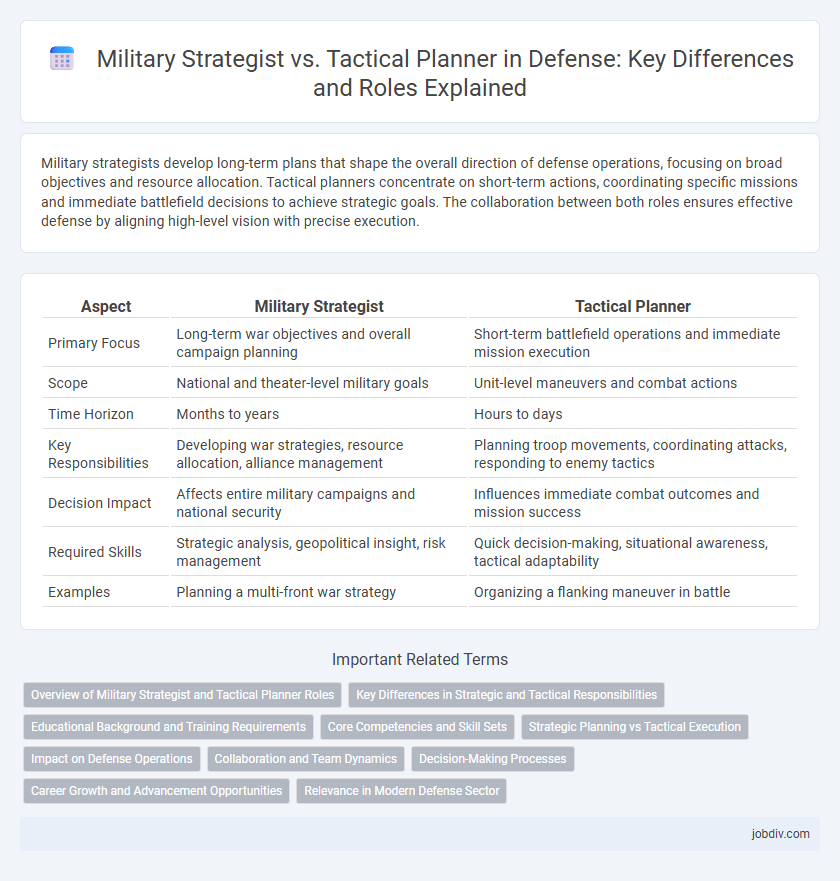Military strategists develop long-term plans that shape the overall direction of defense operations, focusing on broad objectives and resource allocation. Tactical planners concentrate on short-term actions, coordinating specific missions and immediate battlefield decisions to achieve strategic goals. The collaboration between both roles ensures effective defense by aligning high-level vision with precise execution.
Table of Comparison
| Aspect | Military Strategist | Tactical Planner |
|---|---|---|
| Primary Focus | Long-term war objectives and overall campaign planning | Short-term battlefield operations and immediate mission execution |
| Scope | National and theater-level military goals | Unit-level maneuvers and combat actions |
| Time Horizon | Months to years | Hours to days |
| Key Responsibilities | Developing war strategies, resource allocation, alliance management | Planning troop movements, coordinating attacks, responding to enemy tactics |
| Decision Impact | Affects entire military campaigns and national security | Influences immediate combat outcomes and mission success |
| Required Skills | Strategic analysis, geopolitical insight, risk management | Quick decision-making, situational awareness, tactical adaptability |
| Examples | Planning a multi-front war strategy | Organizing a flanking maneuver in battle |
Overview of Military Strategist and Tactical Planner Roles
Military strategists develop long-term plans that integrate national security objectives, resource allocation, and geopolitical considerations to guide overall defense policy and large-scale operations. Tactical planners focus on short-term mission execution, coordinating troop movements, logistics, and battlefield tactics to achieve immediate objectives within operational frameworks. Both roles require deep expertise in intelligence analysis, force capabilities, and threat assessment to ensure effective military outcomes.
Key Differences in Strategic and Tactical Responsibilities
Military strategists focus on long-term objectives, resource allocation, and overall campaign design to achieve national defense goals. Tactical planners concentrate on short-term actions, troop movements, and battlefield execution to implement the strategist's vision effectively. The key difference lies in strategists shaping the broader military vision while tactical planners ensure operational success through detailed, ground-level planning.
Educational Background and Training Requirements
Military strategists typically possess advanced degrees in military history, international relations, or defense studies, often acquired through institutions like war colleges, emphasizing comprehensive education on long-term planning and geopolitical analysis. Tactical planners generally undergo specialized training programs focused on immediate battlefield operations, including courses in combat tactics, logistics, and real-time decision-making, frequently delivered at military academies or through field training exercises. Both roles require rigorous physical conditioning and leadership development, but strategists prioritize analytical skills and broad operational knowledge, while tactical planners emphasize practical application and rapid responsiveness in dynamic combat scenarios.
Core Competencies and Skill Sets
Military strategists excel in long-term planning, threat assessment, and resource allocation to shape overall defense policies and campaigns. Tactical planners focus on real-time decision-making, battlefield coordination, and mission execution to achieve specific operational objectives. Core competencies of strategists include geopolitical analysis, force deployment strategy, and contingency planning, while tactical planners emphasize situational awareness, maneuver tactics, and unit-level leadership.
Strategic Planning vs Tactical Execution
Military strategists concentrate on strategic planning, developing long-term objectives and allocating resources to achieve overarching defense goals. Tactical planners focus on tactical execution, managing battlefield maneuvers and deploying units effectively to accomplish specific missions. The distinction between strategic planning and tactical execution ensures cohesive defense operations aligned with national security priorities.
Impact on Defense Operations
Military strategists shape overarching defense policies by analyzing geopolitical trends and long-term threats, ensuring robust national security frameworks. Tactical planners translate these strategies into actionable battlefield operations, optimizing troop movements, resource allocation, and real-time decision-making. Their coordinated roles enhance defense operations by balancing strategic foresight with operational precision, significantly improving mission success rates and force readiness.
Collaboration and Team Dynamics
Military strategists and tactical planners collaborate by integrating long-term strategic objectives with immediate battlefield actions, ensuring cohesive mission execution. Effective team dynamics rely on clear communication channels and mutual respect between strategic visionaries and tactical implementers to adapt swiftly to evolving combat scenarios. This synergy enhances operational efficiency, enabling armed forces to anticipate threats and optimize resource deployment.
Decision-Making Processes
Military strategists focus on long-term objectives, analyzing complex geopolitical factors and resource allocations to shape overarching defense policies. Tactical planners concentrate on immediate battlefield conditions, optimizing troop movements and logistics to achieve specific operational goals. Their decision-making processes differ in scope and urgency, with strategists emphasizing broad impact and planners prioritizing real-time adaptability.
Career Growth and Advancement Opportunities
Military strategists often experience broader career growth due to their involvement in high-level planning and decision-making that influences long-term defense policies, earning opportunities for leadership roles in defense agencies or joint commands. Tactical planners tend to advance within operational units, gaining expertise in direct combat support and real-time mission execution, which can lead to specialized roles in combat operations or tactical training commands. Both paths offer distinct advancement opportunities, with strategists focusing on policy and doctrine development and planners honing operational leadership skills essential for frontline success.
Relevance in Modern Defense Sector
Military strategists shape overarching defense policies and long-term objectives by analyzing geopolitical landscapes and resource allocation, crucial for national security frameworks. Tactical planners execute these strategies on the battlefield, focusing on immediate objectives, troop movements, and engagement tactics that adapt to dynamic combat scenarios. Their collaboration ensures cohesive defense operations, maximizing mission success through synchronized strategic vision and precise tactical implementation in modern warfare environments.
Military Strategist vs Tactical Planner Infographic

 jobdiv.com
jobdiv.com